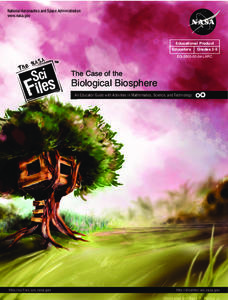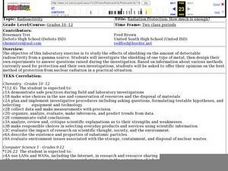PBS
The Sixties: Dylan Plugs in and Sells Out
Before Woodstock, there was Newport. Get plugged in to the social changes of the 1960s with a lesson that looks at Bob Dylan's performance at the 1965 Newport Folk Festival as a symbol of the radical changes that marked the era.
Cornell University
Plant Cell Crime Scene
Use science to solve the mystery of the Poplar murder. Pupils use forensic botany to determine if a suspect could be the killer. By analyzing images from a Transmission Electron Microscope, learners determine if the material found on the...
Shodor Education Foundation
Linear Inequalities
An interactive lesson helps individuals learn to graph inequalities in two variables. Scholars can adjust the interactive to present the inequalities in standard or slope-intercept form.
Teach Engineering
Design Inspired by Nature
Let nature guide your engineering designs. By taking apart a flower, pupils learn about reverse engineering. They use the results to brainstorm designs for new products or ideas. This is the seventh installment of a nine-part Life...
PBS
How to Teach Your Students about Fake News
What media literacy skills do people need to evaluate a news source? Scholars listen to and discuss an NPR story about how fake headlines often dupe young people and adults alike. Next, they study news stories, using a fact-checking...
Curated OER
Explosives
Students assume the role of police detectives and investigate chemical agents used to make explosives and suspected terrorists based on information provided. Students have a list of questions to lead their investigation and must produce...
Curated OER
Vision Of The Future
Students investigate ways in which new vision tests and technologies can be used to help detect and correct vision problems. They begin by reading the Times article, Software May Replace the Eye Chart on the Wall. They stage a medical...
Curated OER
The Case of the Biological Biosphere: Health, Math, Technology
Students investigate various aspects of the human body in this imaginative Tree House Detective episode about the biological biosphere. In a series of They take measurements, analyze data, and use technology. The lessons revolve around...
Curated OER
Feature Column: Virtual Field Trips
Young scholars discover ways to stay healthy by utilizing Internet education software. In this computer technology lesson, students investigate Internet programs that simulate a field trip by showing images and video. Young scholars...
Curated OER
Lead Detection
Students hypothesize whether the soil sample may have lead contamination and why. They describe what they see happening with the soil samples and the corresponding swabs. Pupils write a brief description of what they observe as the...
Curated OER
Detecting Systems
Fourth graders participate in a lesson that attempts to explain how a system works. They examine the parts and how they fit together. The question of what happens to a system if a pert is missing is asked.
Curated OER
Create Your Own Investigation
Students design and implement an experiment intended to measure and analyze the air quality of a particular location. They focus on looking for ozone and particulate pollutants.
Curated OER
How Can You Detect the Invisible?
Students participate in a lab activity in which they examine the characteristics of radon. They identify radon's link to cases of lung cancer. They complete a radon fact sheet and answer questions to end the lesson plan.
Curated OER
Invisible Investigations
Students simulate how charged particles move in a particle detector. In this physics lesson, students observe how iron filings behave when magnetic marbles are passed underneath them. They record and draw their observations.
Curated OER
Detecting Magnetic Materials in "Martian" Soil
Students simulate some of the Pathfinder experiments by devising methods of collecting and measuring magnetic substances in pseudo-Martian soil. The efficiency of each of the methods used to collect materials is evaluated in this lesson.
Curated OER
Check Out Lights and Shields with Beads
Students explore Ultraviolet detecting beads and conduct several investigations with them. In this investigative lesson plan students participate in an experiment to see the harmful effects of UV light and discuss their findings.
Curated OER
Lead Extraction
Students investigate one method used in the detection of lead in the soil. They use a Lead Check Soil Kit to safely obtain results in 30 minutes or less in levels of 400 ppm or above. In addition, they write a brief description of what...
Curated OER
Radiation
Students distinguish between natural and man-made radiation. They measure radiation using a Geiger counter and investigate footprints of radiation.
Curated OER
Harriet The Spy
Fourth graders investigate the style of diary writing as its own genre of literature. They read Harriet The Spy in order to have a text for this literature study. Students use the skill of prediction to preview the story, and then...
Curated OER
RADIATION PROTECTION: HOW MUCH IS ENOUGH?
Young scholars study the effects of shielding on the amount of detectable radioactivity from a gamma source. They investigate the shielding of one type of metal, then design their own experiments to answer questions raised during the...
Curated OER
Have I Been Hacked?
Students investigate how effective SNEAK strategies are in detecting hackers. In this technology lesson, students explain the ethical issues about hacking. They graph and analyze their experimental results.
Curated OER
Using Newsprint as a UV Detector
Students investigate the effects of UV radiation. In this earth science lesson, students explain how the time of day relate to UV abundance on Earth. They determine if weather affects the amount of UV that Earth receives.
Curated OER
Expanding FBI Surveillance Powers After September 11, 2001
Students examine the guidelines put out by the FBI to follow during federal investigations. In groups, they discuss the decision by the FBI to increase surveillance after the terrorist attacks on September 11. They share their opinions...
Curated OER
Paper Planes
In this unit, 3rd graders investigate one variable to see if they can make a paper plane fly farther. They use scatter plots to establish a possible relationship between variables then use what they have found to make a paper plane to...

























